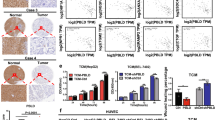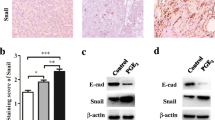Abstract
Purpose
Vascular endothelial growth factor (VEGF) greatly contributes to the progression of hepatocellular carcinoma (HCC). It is reported that a selective cyclooxygenase-2 (COX-2) inhibitor inhibits cellular proliferation and may attenuate VEGF expression in HCC. We propose that different cascades in the VEGF pathway respond to COX-2 inhibition, depending on the cell types.
Methods
The six human HCC cell lines—Hep3B, SNU387, SNU182, SNU423, SNU449, and PLC/PRF5—were cultured under normoxic and hypoxic conditions. Cells were treated with a selective COX-2 inhibitor (NS-398) and discoidin domain receptor 2 (DDR2) siRNA, and microarray analysis was performed.
Results
NS-398 inhibited HCC proliferation and decreased the expression level of VEGF in HCC cells only under normoxia conditions. In hypoxia conditions, VEGF expression level in Hep3B cell was suppressed, while that in SNU387 cell was increased by NS-398 (P < 0.001). The NS-398-induced increase in VEGF expression in SNU387 cell was associated with the up-regulation of the DDR2 gene. NS-398-treated SNU series cells and PLC/PRF5 cells displayed a robust increase in DDR2 mRNA expression. Also, transfection with DDR2 siRNA decreased the VEGF expression level of SNU387, 423, 449 cells under hypoxia conditions (P < 0.05). In vivo chromatin immunoprecipitation assay demonstrated that NS-398 induces the enhancement of HIF-1α binding on VEGF promoter, leading to the increase in VEGF gene expression in hypoxic conditions. There is strong evidence that it is related to the DDR2 gene expression in SNU387 cells.
Conclusion
These findings disclose a novel cell-dependent regulatory mechanism of VEGF involving DDR2 gene in HCC cells.






Similar content being viewed by others
Abbreviations
- COX-2:
-
Cyclooxygenase-2
- DDR2:
-
Discoidin domain receptor 2
- NS-398:
-
[N-(2-cyclohexyloxy-4-nitrophenyl)methanesulfonamide], COX-2 inhibitor
- VEGF:
-
Vascular endothelial growth factor
- siRNA:
-
Small interfering RNA
- HIF-1α:
-
Hypoxia-inducible transcription factor 1α
- ChIP:
-
Chromatin immunoprecipitation
References
Altermann E, Klaenhammer TR (2005) Pathway Voyager: pathway mapping using the Kyoto Encyclopedia of Genes and Genomes (KEGG) database. BMC Genomics 6(1):60. doi:10.1186/1471-2164-6-60
Bae SH, Jung ES, Park YM, Kim BS, Kim BK, Kim DG, Ryu WS (2001) Expression of cyclooxygenase-2 (COX-2) in hepatocellular carcinoma and growth inhibition of hepatoma cell lines by a COX-2 inhibitor, NS-398. Clin Cancer Res 7
Baguma-Nibasheka M, Barclay C, Li AW, Geldenhuys L, Porter GA, Blay J, Casson AG, Murphy PR (2007) Selective cyclooxygenase-2 inhibition suppresses basic fibroblast growth factor expression in human esophageal adenocarcinoma. Mol Carcinog 46(12):971–980
Chao Y, Li CP, Chau GY, Chen CP, King KL, Lui WY, Yen SH, Chang FY, Chan WK, Lee SD (2003) Prognostic significance of vascular endothelial growth factor, basic fibroblast growth factor, and angiogenin in patients with resectable hepatocellular carcinoma after surgery. Ann Surg Oncol 10(4):355–362
Cheng AS, Chan HL, To KF, Leung WK, Chan KK, Liew CT, Sung JJ (2004) Cyclooxygenase-2 pathway correlates with vascular endothelial growth factor expression and tumor angiogenesis in hepatitis B virus-associated hepatocellular carcinoma. Int J Oncol 24
Gately S (2000) The contributions of cyclooxygenase-2 to tumor angiogenesis. Cancer Metastasis Rev 19(1–2):19–27
Gately S, Li WW (2004) Multiple roles of COX-2 in tumor angiogenesis: a target for antiangiogenic therapy. Semin Oncol 31(2 Suppl 7):2–11. doi:S0093775404001897
Harris AL (2002) Hypoxia–a key regulatory factor in tumour growth. Nat Rev Cancer 2(1):38–47
Hu KQ (2002) Rationale and feasibility of chemoprovention of hepatocellular carcinoma by cyclooxygenase-2 inhibitors. J Lab Clin Med 139(4):234–243. doi:S0022214302336047
Iniguez MA, Rodriguez A, Volpert OV, Fresno M, Redondo JM (2003) Cyclooxygenase-2: a therapeutic target in angiogenesis. Trends Mol Med 9(2):73–78. doi:S1471491402000114
Kern MA, Schoneweiss MM, Sahi D, Bahlo M, Haugg AM, Kasper HU, Dienes HP, Kaferstein H, Breuhahn K, Schirmacher P (2004) Cyclooxygenase-2 inhibitors suppress the growth of human hepatocellular carcinoma implants in nude mice. Carcinogenesis 25(7):1193–1199
Koga H, Sakisaka S, Ohishi M, Kawaguchi T, Taniguchi E, Sasatomi K, Harada M, Kusaba T, Tanaka M, Kimura R, Nakashima Y, Nakashima O, Kojiro M, Kurohiji T, Sata M (1999) Expression of cyclooxygenase-2 in human hepatocellular carcinoma: relevance to tumor dedifferentiation. Hepatology 29(3):688–696
Kong SY, Park JW, Lee JA, Park JE, Park KW, Hong EK, Kim CM (2007) Association between vascular endothelial growth factor gene polymorphisms and survival in hepatocellular carcinoma patients. Hepatology 46(2):446–455
Levy AP, Levy NS, Wegner S, Goldberg MA (1995) Transcriptional regulation of the rat vascular endothelial growth factor gene by hypoxia. J Biol Chem 270(22):13333–13340
Li XM, Tang ZY, Zhou G, Lui YK, Ye SL (1998) Significance of vascular endothelial growth factor mRNA expression in invasion and metastasis of hepatocellular carcinoma. J Exp Clin Cancer Res 17(1):13–17
Miura H, Miyazaki T, Kuroda M, Oka T, Machinami R, Kodama T, Shibuya M, Makuuchi M, Yazaki Y, Ohnishi S (1997) Increased expression of vascular endothelial growth factor in human hepatocellular carcinoma. J Hepatol 27(5):854–861. doi:S0168-8278(97)80323-6
Mukhopadhyay D, Datta K (2004) Multiple regulatory pathways of vascular permeability factor/vascular endothelial growth factor (VPF/VEGF) expression in tumors. Semin Cancer Biol 14(2):123–130. doi:10.1016/j.semcancer.2003.09.019
Park JW, Park JE, Lee JA, Lee CW, Kim CM (2006) Cyclooxygenase-2 (COX-2) is directly involved but not decisive in proliferation of human hepatocellular carcinoma cells. J Cancer Res Clin Oncol 132(3):184–192
Park HS, Kim KR, Lee HJ, Choi HN, Kim DK, Kim BT, Moon WS (2007) Overexpression of discoidin domain receptor 1 increases the migration and invasion of hepatocellular carcinoma cells in association with matrix metalloproteinase. Oncol Rep 18(6):1435–1441
Parkin DM, Bray F, Ferlay J, Pisani P (2005) Global cancer statistics, 2002. CA Cancer J Clin 55(2):74–108. doi:55/2/74
Pollak MN, Schernhammer ES, Hankinson SE (2004) Insulin-like growth factors and neoplasia. Nat Rev Cancer 4(7):505–518. doi:10.1038/nrc1387
Poon RT, Ho JW, Tong CS, Lau C, Ng IO, Fan ST (2004) Prognostic significance of serum vascular endothelial growth factor and endostatin in patients with hepatocellular carcinoma. Br J Surg 91(10):1354–1360
Semela D, Dufour J-F (2005) Vascular endothelial growth factor signaling. In: Dufour JF, Clavien PA (eds) Signaling pathways in liver diseases. Springer, Berlin, pp 91–104
Shim JH, Park JW, Kim JH, An M, Kong SY, Nam BH, Choi JI, Kim HB, Lee WJ, Kim CM (2008) Association between increment of serum VEGF level and prognosis after transcatheter arterial chemoembolization in hepatocellular carcinoma patients. Cancer Sci 99(10):2037–2044
Tang TC, Poon RT, Lau CP, Xie D, Fan ST (2005) Tumor cyclooxygenase-2 levels correlate with tumor invasiveness in human hepatocellular carcinoma. World J Gastroenterol 11(13):1896–1902
Tessner TG, Muhale F, Schloemann S, Cohn SM, Morrison A, Stenson WF (2003) Basic fibroblast growth factor upregulates cyclooxygenase-2 in I407 cells through p38 MAP kinase. Am J Physiol Gastrointest Liver Physiol 284(2):G269–G279
Vogel W, Gish GD, Alves F, Pawson T (1997) The discoidin domain receptor tyrosine kinases are activated by collagen. Mol Cell 1(1):13–23. doi:S1097-2765(00)80003-9
Vogel WF, Abdulhussein R, Ford CE (2006) Sensing extracellular matrix: an update on discoidin domain receptor function. Cell Signal 18(8):1108–1116. doi:10.1016/j.cellsig.2006.02.012
von Marschall Z, Cramer T, Hocker M, Finkenzeller G, Wiedenmann B, Rosewicz S (2001) Dual mechanism of vascular endothelial growth factor upregulation by hypoxia in human hepatocellular carcinoma. Gut 48(1):87–96
Wang D, DuBois RN (2004) Cyclooxygenase 2-derived prostaglandin E2 regulates the angiogenic switch. Proc Natl Acad Sci USA 101(2):415–416
Wang Y, Sun Y (2002) Insulin-like growth factor receptor-1 as an anti-cancer target: blocking transformation and inducing apoptosis. Curr Cancer Drug Targets 2(3):191–207
Williams CS, Mann M, DuBois RN (1999) The role of cyclooxygenases in inflammation, cancer, and development. Oncogene 18(55):7908–7916. doi:10.1038/sj.onc.1203286
Wu T (2006) Cyclooxygenase-2 in hepatocellular carcinoma. Cancer Treat Rev 32(1):28–44. doi:10.1016/j.ctrv.2005.10.004
Wu XZ, Chen D (2006) Cell-matrix talks: effects on differentiation of hepatocellular carcinoma. Minerva Gastroenterol Dietol 52(4):407–413
Wu XZ, Xie GR, Chen D (2007) Hypoxia and hepatocellular carcinoma: the therapeutic target for hepatocellular carcinoma. J Gastroenterol Hepatol 22(8):1178–1182
Xie K, Wei D, Shi Q, Huang S (2004) Constitutive and inducible expression and regulation of vascular endothelial growth factor. Cytokine Growth Factor Rev 15(5):297–324. doi:10.1016/j.cytogfr.2004.04.003
Yang JD, Nakamura I, Roberts LR (2011) The tumor microenvironment in hepatocellular carcinoma: current status and therapeutic targets. Semin Cancer Biol 21(1):35–43. doi:10.1016/j.semcancer.2010.10.007
Zhao QT, Yue SQ, Cui Z, Wang Q, Cui X, Zhai HH, Zhang LH, Dou KF (2007) Potential involvement of the cyclooxygenase-2 pathway in hepatocellular carcinoma-associated angiogenesis. Life Sci 80(5):484–492
Acknowledgment
This study was supported by a grant from the National Cancer Center, Korea (#0810260, #1110050).
Author information
Authors and Affiliations
Corresponding author
Rights and permissions
About this article
Cite this article
Lee, N.O., Park, JW., Lee, J.A. et al. Dual action of a selective cyclooxygenase-2 inhibitor on vascular endothelial growth factor expression in human hepatocellular carcinoma cells: novel involvement of discoidin domain receptor 2. J Cancer Res Clin Oncol 138, 73–84 (2012). https://doi.org/10.1007/s00432-011-1075-0
Received:
Accepted:
Published:
Issue Date:
DOI: https://doi.org/10.1007/s00432-011-1075-0




